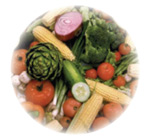FDA Home Page |
CFSAN Home |
Search/Subject Index |
Q & A |
Help

Talking About Trans Fat
What You Need to Know
(Also available in PDF, 455 KB,
and en Español)
Trans Fat at-a-Glance
Trans fat is a specific type of fat that is formed when liquid oils are turned into solid fats, such as shortening or stick margarine. During this process
— called hydrogenation — hydrogen is added to vegetable oil to increase the shelf life and flavor stability of foods. The result of the process is trans fat.
- Trans fat can be found in many of the same foods as saturated fat, such as vegetable shortenings, some margarines, crackers, candies, cookies, snack foods, fried foods, baked goods, and other processed foods made with partially hydrogenated vegetable oils.
- Also known as trans fatty acids, trans fat can be found naturally in some foods — such as animal-based foods like milk, milk products, and meat.
As a consumer, the most important thing to know about trans fat is that it behaves like saturated fat in the body by raising low-density lipoprotein (LDL, or "bad") cholesterol — which can increase your risk of coronary heart disease.
Read on to learn more about trans fat — and how you can make wise nutritional choices in order to limit the trans fat, as well as saturated fat and cholesterol, in your diet.
Fats in Your Diet
Fat is a major source of energy for the body, and aids in the absorption of vitamins A, D, E, and K, as well as carotenoids. Both animal- and plant-derived food products contain fat, and fat is important for proper growth, development, and maintenance of good health.
However, experts recommend that you get about one third or less of your calories (i.e., between 20 and 35 percent of calories) from fat.
As a food ingredient, fat provides flavor, consistency, and stability — and helps you feel full.
Infants and toddlers up to age two have the highest energy needs per unit of body weight of any age group. Fats are an important source of calories and nutrients for these youngsters.
A Lesson in Body Chemistry
Many consumers are already aware that it's a good idea to limit saturated fat and cholesterol in their diet...but trans fat is a less familiar term. When it comes to trans fat and your body, here's how it works:
- Like saturated fat and cholesterol, trans fat raises low-density lipoprotein (LDL, or "bad") cholesterol in the blood, which increases the risk of developing coronary heart disease.
- Trans fat also lowers high-density lipoprotein (HDL, or "good") cholesterol in the blood.
- To reduce the risk of developing coronary heart disease, the goal is to decrease your overall level of LDL cholesterol. Reducing the amount of saturated fat, trans fat, and cholesterol in your diet may help decrease your LDL cholesterol level.
Choose Your Fats Wisely: A Dietary Checklist
There are actions you can take every day to keep your consumption of trans fat (as well as saturated fat and cholesterol) low while still eating a nutritionally adequate diet.
- Check the Nutrition Facts label to compare foods. Serving sizes are generally consistent in similar types of foods, so choose foods lower in saturated fat, trans fat, and cholesterol. You should check all three nutrients to make choices for a healthful diet.
- Choose foods low in saturated fat and cholesterol by following this general rule of thumb: 5% Daily Value or less is low, and 20% Daily Value or more is high. Trans fat has no Daily Value, so keep the number of foods you choose containing trans fat as low as possible.
- Choose alternative fats. Replace saturated and trans fats in your diet
with mono- and polyunsaturated fats. Most dietary fats should come from sources of mono- and polyunsaturated fatty acids.
- Sources of monounsaturated fats include olive and canola oils.
- Sources of polyunsaturated fats include soybean, corn, and sunflower oils, and foods like nuts.
- Choose vegetable oils (except coconut and palm kernel oils)
and soft margarines (liquid, tub, or spray) more often. The combined
amount of saturated and trans fats in these products is lower than the amount
in solid shortenings, hard margarines, and animal fats, including butter.
- Choose foods low in saturated fat, such as fat-free or
low-fat milk and milk products, lean meats, fish, skinless poultry, whole-grain foods,
and fruits and vegetables.
- Limit foods high in cholesterol, such as liver and other
organ meats, egg yolks, and full-fat milk and milk products, like whole milk.
- Choose lean meats, such as poultry (without skin and not
fried), lean beef and pork (with visible fat trimmed and not fried).
- Consider fish. Most fish are lower in saturated fat than
meat. In addition, some fish, such as trout, herring, and salmon, contain omega-3
fatty acids. These are being studied to determine if they may even offer protection
against heart disease.
Some Healthy Choices

Fruits and Vegetables |

Grains |

Lean Meats |

Fish |
Getting the Scoop
on Trans Fat
Labeling Update:
Check Trans Fat on the
Nutrition Facts Label!

How can you know how much trans fat a food product contains? As of January 1, 2006, food manufacturers are now required to list the amount of trans fat on all product labels.
Spreading the News:
Butter v. Margarine
Some margarine contains more trans fat than butter — but that doesn't mean you should choose butter over margarine. The combined amount of saturated fat and trans fat, and the amount of cholesterol for butter is usually higher than it is for margarine.
- Soft or liquid margarines contain a lower combined amount of saturated fat and trans fat and a lower amount of cholesterol.
- Nonstick cooking spray can be substituted for other fats when "greasing" the pan.
Finding out when Eating out
Restaurants are not required to provide full nutrition labeling for their food products, unless nutrient claims are made, such as "Low Fat" or "Low Sodium." So, you may not learn how much saturated or trans fat is in a food unless you ask
- To know which fats are being used in the preparation of the food you're ordering, remember to "ask before you order."
- Many fast food or chain restaurants have tables of nutritional content of their food products that they will provide upon request.







